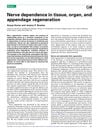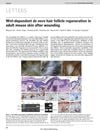Cellular and Molecular Mechanisms of Repair in Acute and Chronic Wound Healing
July 2015
in “
British Journal of Dermatology
”
TLDR Acute wounds heal well, but chronic wounds struggle due to ongoing inflammation and poor tissue repair.
The document discussed the cellular and molecular mechanisms of wound healing, focusing on the differences between acute and chronic wounds. Acute wounds healed efficiently through coordinated cell activities, while chronic wounds, often seen in aging populations and those with diabetes or obesity, posed therapeutic challenges due to persistent inflammation and defective tissue repair. Zebrafish and Drosophila were introduced as models for studying wound healing. The study highlighted the roles of immune cells, fibroblasts, and keratinocytes in acute healing, and noted that chronic wounds were characterized by hyperproliferative keratinocytes, senescent fibroblasts, and elevated MMPs. The research emphasized the need for collaboration between researchers and clinicians to develop new treatments, and suggested that understanding these mechanisms could lead to therapeutic advancements in wound care.


